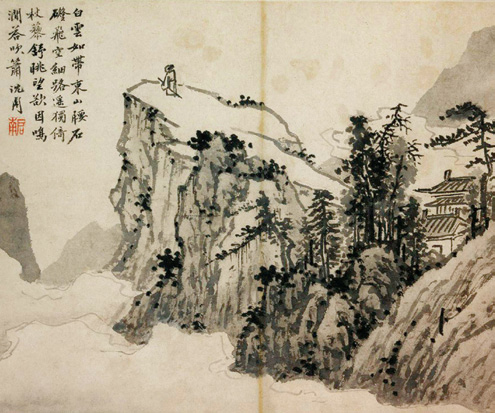An Illustrated Outline of Buddhism: The Essentials of Buddhist Spirituality (31 page)
Read An Illustrated Outline of Buddhism: The Essentials of Buddhist Spirituality Online
Authors: William Stoddart,Joseph A. Fitzgerald
Tags: #Philosophy

100
An Illustrated Outline of Buddhism
that everything under the sun, including even a great spiritual dynasty,
has both a beginning and an end, and, when the appointed time has
come, must needs pass away. However the celestial principle which
the Dalai Lamas incarnated is imperishable. One recal s the saying of
Christ: “Heaven and earth will pass away, but My words will not pass
away.”
Young Tibetan Buddhist woman
In other living creatures, ignorance of Self is nature; in man it
is a vice.
The Buddha


101
(18) China
i. The Introduction of Buddhism into China
Buddhism was introduced into China during the first century A.D.
and the immediately succeeding centuries. It is said traditional y that
this was on the order of the mythical Yellow Emperor, Fu-Hsi, and the
venerable Founder of Taoism, Lao Tzu, who were regarded as possess-
ing immortality.
On the one hand, Indian Buddhist monks entered China as mis-
sionaries. On the other hand, Chinese pilgrims traveled to India to
visit the earliest and most sacred Buddhist shrines and to learn about
Buddhism, thereafter returning to their own country to spread the
message. From that time onwards, in China, Buddhism and the indig-
enous traditions of Confucianism and Taoism were called “the Three
Teachings” or “the Three Religions”.
Early in the fifth century A.D., Fa-Hsien, after an arduous journey
through central Asia, reached India. He spent fifteen years in India
and Ceylon and compiled a detailed account of Buddhism that is re-
nowned in China to this day. In the year 520 A.D., Bodhidharma left
India and became the first patriarch of
Ch’an
Buddhism in China. In
the seventh century, during the T’ang Dynasty, the monk Hsüan-Tsang
traveled through East Turkestan and Afghanistan to India, eventual y
returning to China laden with Buddhist books and manuscripts, hun-
dreds of which he translated into Chinese.
The
Vajrayāna
or tantric doctrines were brought to China (under
the name of
Mi-tsung
)
by the three Indian masters Shubhākarasimha
(637-735), Vajrabodhi (663-723), and Amoghavajra (705-774).
During the sixth to ninth centuries (the Sui and T’ang dynasties),
several great schools of Chinese Buddhism developed. These are:
School
Literal Meaning
Founder
School
in Japan
Hua-yen “Flower Garland”
Fa-tsang (643-712)
Kegon
Tien-Tai
“Heavenly Terrace”
Chih-i (538-597)
Tendai
Mi-tsung “School of Secrets”
Shubhākarasimha (637-735) Shingon
Ch’an
“Contemplation”
Bodhidharma (470-543)
Zen
Ching-t’u “Pure Land”
Tan-Luan (476-542)
Jōdo
Fa-hsiang “Dharma-Character” Hsüan-Tsang (600-664)
Hossō


102
An Illustrated Outline of Buddhism
The “Dharma-Character” school (
Fa-hsiang
in Chinese;
Hossō
in
Japanese) was also known as the “Consciousness-Only” school (
Wei-
shih
in Chinese;
Yuishiki
in Japanese). It never flourished in Japan to
the extent that it did in China.
For the Indian precursors of some of the Chinese schools, and for
fuller information on the Japanese schools or sects, see pp. 55, 58, 116-
117, and 121.
Shen Zhou,
Poet on a Mountain Top
, Ming Dynasty, China
Whoever speaks or acts with an impure mind, him sorrow fol-
lows, as the wheel fol ows the steps of the ox that draws the cart.
Dhammapada, 2



China
103
Statue of Bodhisattva Kwan-Yin, Shanxi, China, 1100
It is useless to try to force to believe those who will not, for even
the Buddha cannot do that.
Hōnen

104
An Illustrated Outline of Buddhism
ii. The Chinese Dynasties
c. 2800 B.C.
c. 3700 B.C.-2000 B.C. Neolithic culture
Fu-Hsi, the First
Emperor, author of
c. 1766 B.C.-1122 B.C. Shang-Yin Dynasty
the
I Ching
1122 B.C.-221 B.C.
Chou Dynasty
c. 563 B.C. birth
of the Buddha in
North India
c. 722 B.C.-481 B.C.
Spring and Autumn Annals
c. 481 B.C.-221 B.C.
Warring States
221 B.C.-206 B.C.
Ch’in Dynasty (Empire of Shih Huang Ti)
206 B.C.-220 A.D.
Han Dynasty
Buddhism in the
220 A.D.-589 A.D.
Six Dynasties
first and succeeding
centuries A.D.
220 A.D.-280 A.D.
Three Kingdoms
386 A.D.-589 A.D.
North [Wei Tartars] (386 A.D.-581 A.D.)
in the fourth century
386 A.D.-535 A.D.
North:
Fa-Hsien wrote an
Wei Tartars
account of Indian
Buddhism
535 A.D.-557 A.D.
Western Wei
557 A.D.-581 A.D.
Northern Chou
534 A.D.-550 A.D.
Eastern Wei
550 A.D.-577 A.D.
Northern Ch’i
South [Native Dynasties] (420 A.D.-589 A.D.)
420 A.D.-478 A.D.
Liu Sung
479 A.D.-501 A.D.
Southern Ch’i

